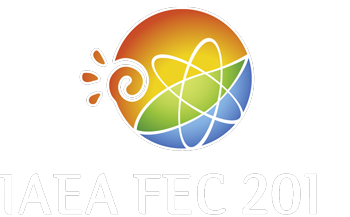Speaker
Dr
George McKee
(University of Wisconsin-Madison)
Description
Low-wavenumber density fluctuations exhibit rapidly changing characteristics during the current ramp-up phase of ITER-like discharges that reflect a complex interaction between evolving electron transport, safety factor (q) and kinetic profiles and low-order rational surfaces. These measurements and analysis can explain discrepancies between various transport models and measurements during the critical ramp-up phase. ITER similar shape plasmas were performed on DIII-D to characterize performance and measure comprehensive turbulence characteristics. Comparison of these fluctuations, transport and profiles with simulations is aimed at developing a validated transport model that incorporates the unique characteristics of the ramp-up phase.
Transient windows of suppressed fluctuations are observed during ramp-up, which correspond to low-order-rational q-surfaces entering the plasma that are associated with regions and times of improved transport; the local electron temperature exhibits transient increases during these periods of reduced fluctuations. Measurements of the 2D fluctuation properties, obtained across the outer half-radius with Beam Emission Spectroscopy, illustrate the complex behavior of turbulence during current ramp-up. Density fluctuations at rho=0.55 exhibit fluctuations that decrease in amplitude with time. At rho=0.82, a very large amplitude burst of low-frequency turbulence occurs early in the current ramp, simultaneously with a set of Reversed-Shear Alfven Eigenmodes (RSAEs). A Geodesic Acoustic Mode (GAM) is evident with a frequency that increases with time as T_e increases. The scrape-off-layer T_e profile cools and narrows during the ramp-up as the core heats, consistent with increased energy confinement time at lower q_95. The amplitude profile of low-k fluctuations exhibits a strong reduction in turbulence with reduced q_95; thermal energy confinement likewise increases with decreasing q_95. Comparison of turbulence properties with time-varying linear growth rates with GYRO and GENE will allow for the development of a more complete and accurate model of transport properties during the current ramp phase.
| Country or International Organization | United States of America |
|---|---|
| Paper Number | EX/P3-10 |
Author
Dr
George McKee
(University of Wisconsin-Madison)
Co-authors
Dr
Christopher Holland
(University of California San Diego, 9500 Gilman Dr., La Jolla, CA 92093-0417, USA)
Mr
Dmitry L. Rudakov
(University of California San Diego, 9500 Gilman Dr., La Jolla, CA 92093-0417, USA)
Dr
G. Wang
(University of California Los Angeles, PO Box 957099, Los Angeles, CA 90095-7099, USA)
Dr
Gary L. Jackson
(General Atomics, PO Box 85608, San Diego, CA 92186-5608, USA)
Dr
Jose A. Boedo
(University of California San Diego, 9500 Gilman Dr., La Jolla, CA 92093-0417, USA)
Dr
L. Zeng
(University of California Los Angeles, PO Box 957099, Los Angeles, CA 90095-7099, USA)
Dr
Max Austin
(University of Texas-Austin, Austin, Texas, USA)
Dr
R. Bravenec
(Fourth State Research, 503 Lockhart Dr., Austin, TX 78704, USA)
Dr
Terry L. Rhodes
(University of California Los Angeles, PO Box 957099, Los Angeles, CA 90095-7099, USA)
Dr
Timothy C. Luce
(General Atomics, PO Box 85608, San Diego, CA 92186-5608, USA)
Ms
Zheng Yan
(University of Wisconsin-Madison, 1500 Engineering Dr., Madison, WI 53706-1687, USA)
Dr
yan zhao
(University of Wisconsin-Madison & Suzhou University, Suzhou, China)

